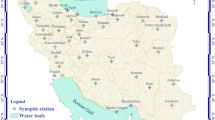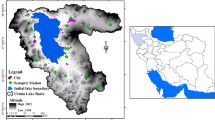Abstract
The Helmand Basin in Iran and Afghanistan is among the areas that have often faced drought due to hot and dry weather. The frequency and severity of the droughts have imposed immense damages to the inhabitants of this area. Such a condition increased climate vulnerability, desertification, and migration. In this study, drought event in Helmand basin during past three decades was detected and forecasted until 2100 by atmosphere general circulation models. For this purpose, daily precipitation and temperature data from 1990 to 2017 were extracted from the GPCC database produced by the German Meteorological Organization. In order to accurately analyze the droughts of Helmand drainage basin, drought changes in the basin were investigated over three periods; 1990–1999, 2000–2009, and 2010–2017. Investigating the droughts condition of Helmand basin over the period from 1990 to 2017 showed that towards recent periods, the extent of severely droughts increased and the extent of severely and very extremely wet has decreased significantly. Forecasting results of Helmand basin droughts by atmosphere general circulation models indicated that from the first 30-year to the last 30-year period, the area of wet and dry would decrease and increase, respectively. Such a condition can be seen in all three scenarios of RCP 2.6, RCP 4.5, and RCP 8.5.





Similar content being viewed by others
Notes
Representative Concentration Pathway
Canadian Earth System Model
References
Aadhar S, Mishra V (2018) Impact of climate change on drought frequency over India. Ministry of Environment, Forest and Climate Change
Abdulai PJ, Chung ES (2019) Uncertainty assessment in drought severities for the Cheongmicheon Watershed using Multiple GCMs and the Reliability Ensemble Averaging Method. Sustainability 11(16):4283
Arora S, Thornton K, Murata G, Deming P, Kalishman S, Dion D, Kistin M (2011) Outcomes of treatment for hepatitis C virus infection by primary care providers New England. J Med 364(23):2199–2207
Bell SS, Chand SS, Camargo SJ, Tory KJ, Turville C, Ye H (2019) Western North Pacific tropical cyclone tracks in CMIP5 models: Statistical assessment using a model-independent detection and tracking scheme. J Clim 32(21):7191–7208
Danandeh A, Sorman AU, Kahya E, Hesami Afshar M (2020) Climate change impacts on meteorological drought using SPI and SPEI: case study of Ankara, Turkey. Hydrol Sci J 65(2):1–14
Dargahian F, Parvaneh B, Shiravand H (2015) Prediction of drought situation in Lorestan province during the period 2030-2011 using the downscaling of output of 4 atmospheric circulation models. Geogr Land 12(45):1–14
Farsani IF, Farzaneh MR, Besalatpour AA, Salehi MH, Faramarzi M (2019) Assessment of the impact of climate change on spatiotemporal variability of blue and green water resources under CMIP3 and CMIP5 models in a highly mountainous watershed. Theor Appl Climatol 136(1-2):169–184
Huang J, Zhai J, Jiang T, Wang Y, Li X, Wang R, Fischer T (2018) Analysis of future drought characteristics in China using the regional climate model CCLM. Clim Dyn 50(1-2):507–525
Javizadeh S, Hejazizadeh Z (2019) Analysis of Drought Spatial Statistics in Iran. Res Geograph Sci 19(53):251–277
King, J., Washington, R., Dyer, E., Engelstaedter, S. (2018). Representation of East African Rainfall in CMIP5 Models. In EGU General Assembly Conference Abstracts, 20, 6659.
Knutti R, Sedláček J (2013) Robustness and uncertainties in the new CMIP5 climate model projections. Nat Clim Chang 3(4):369–373
Moafi SF, Mousavi BM, Ansari H (2013) Prediction of drought situation in Khorasan Razavi province during 2011-2030- using statistical downscaling of LARS-WG5 model output. Geograph Environ Hazards 1(3):2–38
Mohammadi S, Naseri F, Nazaripour H (2018) Investigation of temporal changes and the effect of meteorological drought on groundwater resources of Kerman plain using standard precipitation indices (SPI) and groundwater resources (GRI). Eco Hydrol 5(1):11–22
Nazaripour H (2016) Calibration of rainfall-river flow relationships to assess and predict hydrological drought in the Lut desert catchment (Iran). J Water Resourc Eng 9(31):73–90
Preethi B, Ramya R, Patwardhan SK, Mujumdar M, Kripalani RH (2019) Variability of Indian summer monsoon droughts in CMIP5 climate models. Clim Dyn 53:1937–1962
Sari Sarraf B, Mahmoudi S, Zanganeh S, Pashaei Z (2015) Monitoring and forecasting of wet season and drought in Tabriz using CLIMGEN model and SPI index. Hydro Geomorphol 1(2):61–78
Sidiqi M, Shrestha S, Ninsawat S (2018) Projection of climate change scenarios in the Kabul River Basin, Afghanistan. Curr Sci 114(6):1304
Ting M, Seager R, Li C, Liu H, Henderson N (2018) Mechanism of future spring drying in the Southwestern United States in CMIP5 models. J Clim 31(11):4265–4279
Yang H, Huntingford C (2018) Brief communication. Drought likelihood for East Africa. Nat Hazards Earth Syst Sci 18(2):491–497
Yousefizadeh R, Dadashi Tonekaboni N, Hashemian SM, Maleki H (2015) Assessment of rainfall and drought conditions during 2015 to 2030 using downscaling of atmospheric circulation model Case study: North of Kavir plain of Iran, Fifth Conference on Climate Change. Meteorological Organization, Tehran
Zarei A, Moghimi MM, Bahrami M (2017) Monthly drought monitoring and forecasting using standard precipitation index and markov chain (case study: Southeastern Iran). Geogr Environ Sustain 7(2):39–51
Author information
Authors and Affiliations
Corresponding author
Additional information
Responsible Editor: Zhihua Zhang
Rights and permissions
About this article
Cite this article
Dargahian, F., Doostkamian, M. Detecting and forecasting Helmand basin droughts using RCP scenarios. Arab J Geosci 14, 625 (2021). https://doi.org/10.1007/s12517-021-06733-z
Received:
Accepted:
Published:
DOI: https://doi.org/10.1007/s12517-021-06733-z




